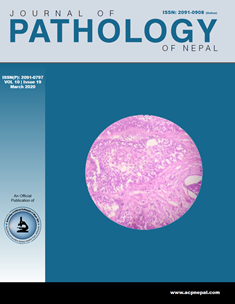Polypoidal lesions of the gastrointestinal tract
DOI:
https://doi.org/10.3126/jpn.v10i1.27743Keywords:
Gastrointestinal tract, Polypoidal lesion, NeoplasticAbstract
Background: With increasing usage of endoscopic procedures, gastrointestinal polypoidal lesions are commonly encountered specimens. Histopathological examination is crucial as biological behavior is dependent on its pathological nature.
Materials and Methods: A retrospective descriptive study performed in Pathology department, Om Hospital and Research Centre from January 2017 to June 2019. The study included lesions received as polyp or polypoidal lesions of gastrointestinal tract for histopathological examination. Data was analysed using SPSS version 17.0. Gender, number and site were analysed using Chi square test to evaluate its association with neoplastic nature. Correlation with age and size was tested with Pearson’s correlation coefficient.
Results: Among 150 cases of gastrointestinal tract polypoidal lesions, 58% were seen in male and 42% in female. Hyperplastic polyp and conventional adenoma were the commonest non-neoplastic and neoplastic lesions respectively. The age of patients ranged from 7 to 84 years with a mean age of 50 years. Rectosigmoid region was the commonest site. 134 patients had single and 16 had multiple polypoidal lesions. Most polypoidal lesion had size <1 cm. Gender, age, number and size showed no correlation with neoplastic nature. A significant association was found with site with notably higher number of neoplastic lesions in large intestine.
Conclusion: A spectrum of histological types of polypoidal lesions were found in Gastrointestinal tract, most frequently in colorectal region. Hyperplastic polyp and adenomatous polyp were the commonest non-neoplastic and neoplastic lesions respectively. A notably higher number of polypoidal lesions in the large intestine were found to be neoplastic in nature.
Downloads
Downloads
Published
How to Cite
Issue
Section
License
This license enables reusers to distribute, remix, adapt, and build upon the material in any medium or format, so long as attribution is given to the creator. The license allows for commercial use.




